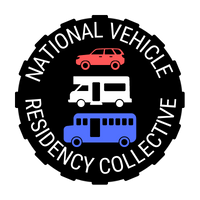January 16, 2025
The Western US has once again witnessed the wrath of wildfires. Blazes have devoured homes and upended lives, this time in California’s most populated city of Los Angeles. As a recent New York Times article revealed (January 13, 2025), many folks who lost their homes to the flames have taken refuge in vehicles. Over 90,000 people have been displaced so far, some joining over 20,000 vehicle residents already living on public streets across LA County (LAHSA 2024). Yet all too often, vehicle dwellers are driven away from their communities by towing laws, parking restrictions, and neighborhood complaints.
Displacement into a car, van, truck, trailer or recreational vehicle (RV) can feel like a descent into chaos. And yet, displaced residents often have no alternative accommodation. Emergency shelters fill up quickly. Hotel vouchers from disaster relief agencies are short-lived. Waiting lists for affordable housing can stretch on for years. Meanwhile, post-fire rebuilding drags on, complicated by insurance battles that may take months or years to resolve and the high cost of massive property clean-up and reconstruction. During this limbo, vehicle living often becomes the most viable solution.
Los Angeles is no stranger to this phenomenon. After major incidents like the 2018 Paradise Camp Fire and the 2020 Santa Cruz CZU Lightning Complex Fires in Northern California, a wave of people seeking refuge poured into urban areas, such as L.A., where housing was already at a crisis point. Instead of encountering supportive programs or well-designed safety nets, many of these individuals found themselves facing yet another displacement threat in the city’s crackdown on vehicle residents. In 2019, LA government authorities impounded nearly 10,000 vehicles in a single month, many of them due to enforcement of the 72-hour parking rule.
Municipal codes set strict limits on where, when, and how long vehicles can be parked. Los Angeles has expanded zones with overnight parking restrictions that target “oversized vehicles” like RVs – over 300 zones were in the council district ravaged by the Palisades Fire. Enforcement sweeps target those sheltering in vehicles, displacing them again and again. Overnight parking bans, aggressive towing, and punitive ticketing measures destabilize people who are already reeling from disaster. This pattern repeats itself every fire season: if the flames don’t drive you out, city policies just might.
In the short term, the survival of many Angelenos who lost their homes to fire hinges on the generosity of local communities, churches, and nonprofits. But as soon as the news cycle shifts and the city enforces parking restrictions, newly unhoused families will be branded as “illegal campers” and pushed out. They are, in essence, denied the right to remain in the very places they’ve lived, worked, and contributed. This is a longer, quieter trauma—a revolving door of parking tickets, towing, and punitive city ordinances that outlaw the very act of survival. In effect, one natural disaster begets another human-made one.
It doesn’t have to be this way. Civic leaders have a moral and economic responsibility to ensure these Angelenos aren’t treated like criminals. We’re calling on Los Angeles to institute a 3-tiered safety net for fire-displaced vehicle residents:
Safe Parking Zones: Immediately establish designated parking areas with 24/7 security and sanitation. Such zones must be large enough to accommodate individuals and families who need a stable place to stay for weeks—or even months—while recovering or searching for new housing. Employ displaced residents as security to ensure safety for all. All too often, vehicle residents are ushered to remote industrial zones, far from the social networks and resources they rely on. Locate these safe parking zones within the affected communities. This model allows families to keep kids in the same school district and stay connected with familiar neighbors and coworkers—essential anchors after such life-altering disasters.
Mobile Water, Sanitation and Hygiene (WASH) Stations: Deploy mobile units offering free showers, toilets, laundry services, and potable water. These could be partially funded by federal disaster aid programs and operated by local nonprofits. Water, sanitation, and hygiene access is more than a convenience—these are essential for human health and dignity. It’s time Los Angeles capitalized on mobile hygiene units—trucks outfitted with showers, sinks, and toilets—to regularly visit safe parking zones.
Community Resource Hubs: Integrate food distribution, job placement, mental health services, and housing navigation into the safe parking zones. Place satellite offices from city departments like Housing and Economic Development on-site once a week, so vehicle residents can apply for assistance without having to drive across town. Local health clinics can provide pop-up medical stations a few days per week including services such as blood pressure checks, flu shots, and mental health counseling. Such integrated services not only keep vehicle residents healthy, but also open lines of communication to long-term resources.
The window for action is now, while discussions about wildfire prevention and relief efforts are front and center. We at the National Vehicle Residency Collective call on city leaders, advocates, and residents to demand safe parking policies as a cornerstone of disaster planning. Creating these designated spaces for vehicle residents is both a moral and practical imperative. While recovery efforts focus on rebuilding homes and repairing infrastructure, we must also ensure that people have a safe place to go in the meantime—especially those who grew up, contributed, and built their lives in these communities. Uprooting them again repeats the disaster.
Our call is simple: Before the next round of sweeps, and certainly before the next fires ignite, we urge local leaders to establish secure parking areas and implement policies that recognize vehicle residency as a legitimate emergency shelter option.
The National Vehicle Residency Collective
Graham Pruss, PhD, Executive Director
Tristia Bauman, JD, Cofounder
Ruth Tretter, PhD, RN, Research Director
Mary Feuer, Outreach Director
Linda Bryant, MBA, Program Director
Simon Han, Member
Sam Lutzker, Member
